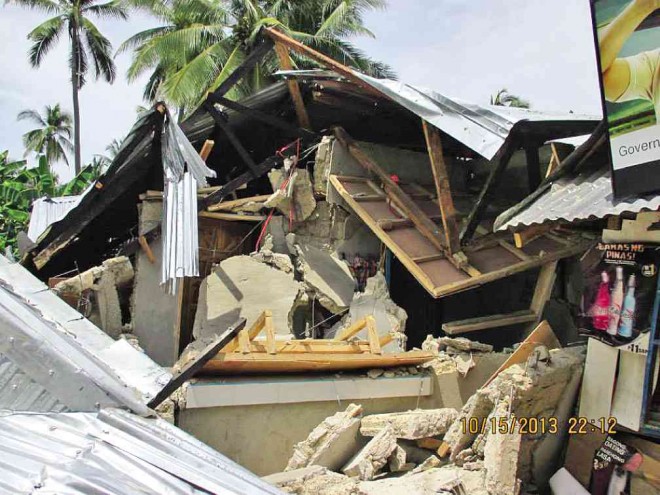
THIS HOUSE located in Barangay Lawis, Pangangan Island, is among those destroyed by the 7.2-magnitude quake that hit Bohol province last week.
Like most of her neighbors, Rufina Forones lost her house in Barangay Lawis on Pangangan Island in Calape town when the earthquake struck Bohol province last week. The challenge of rebuilding one has been as formidable as ever for them.
“We lost our belongings, all of them. All we got are the clothes we wore last Tuesday. We need a sufficient amount of money to rebuild our house,” Forones said. The only item she recovered from their destroyed house was a gas stove.
The woman could not avail herself of a housing loan from the government’s Home Development Mutual Fund or Pag-Ibig Fund. She has only a tax declaration, not a land title, to show for an occupancy document since the Department of Environment and Natural Resources declared Pangangan a protected area in 1991.
Her plight is shared by 2,000 families spread in eight villages (barangay) on the island. Almost all of the lots do not have titles, according to Calape Mayor Dionie Yu.
Yu said the village chiefs had been asking the government to lift the declaration so the residents could have land titles, but nothing had happened so far.
Calape is among the towns badly hit by the earthquake in Bohol. Five people were killed while more than 200 others were injured, Yu said.
About 90 percent of the houses were destroyed, affecting more than 6,000 families. In Barangay Lawis alone, only two houses were left standing.
A bridge made of stones, limestones and concrete that connects Pangangan to the mainland has been rendered impassable to four-wheel vehicles.
Forones, 46, recalled that when the ground shook on October 15, she was buying a kilo of rice at the “sari-sari” store. Her husband and youngest son were on their way to watch a basketball game.
“God somehow made us leave our house before the quake,” she said. “I considered it a blessing.”
The family rushed to the mainland where they felt safer, but unfortunately, they were not able to bring anything with them. Now, they are staying in an open lot owned by Forones’ sister.
To rebuild their house—a product of her husband’s earnings when he worked as a seafarer for two decades—Forones must have a land title as a requirement in getting a housing loan from the Pag-Ibig. The agency’s regional public information officer, Dale Mark Antonio, said the document would be used as loan collateral.
Antonio said survivors without land titles could instead apply for calamity loans. For faster release of the loans, the Pag-Ibig has waived some of the requirements, such as certifications that they are indeed victims and that they are residents of the affected barangay.
Applicants only have to fill out a form and submit photocopies of two valid IDs, one-month pay slip, member’s data form and the certifications.
If they could not produce a pay slip, Antonio said it was enough for them to indicate their gross income.
The Pag-Ibig may grant a calamity loan of up to 80 percent of the member’s total contribution and release it within 90 days upon submission of the filled-out application form.
But for Forones, a calamity loan is not sufficient to rebuild their house. She insists on securing a housing loan and starting their life anew.